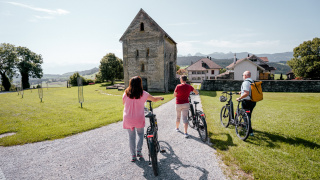The ancient walls of the Rüeggisberg Monastery tell a story that dates back almost 1,000 years. Anyone who wanders through the mysterious ruins of the once-mighty monastery and enjoys the expansive view of the Bernese Oberland will feel themselves immediately transported back to a time of monks, friars and choral singers.
In the 11th century, the rich nobleman Lütold von Rümligen donated property to the town of Cluny in French Burgundy. A remarkable church was planned for Rüeggisberg. Over the next one hundred years, an imposing Romanesque basilica with several additional structures was constructed from the first simple cells. Today, ancient foundation walls, imposing pillars and impressive arches still bear witness to the former size of this influential order of monks from France.
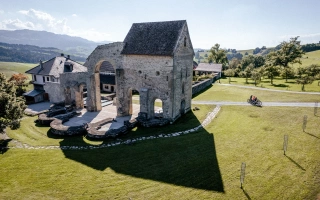
The monastery is known as the first settlement of the French Cluniacs in German-speaking Switzerland. Thanks to the extraordinary amount of property owned by the order – with parts of it stretching from the Emmental valley all the way to Schwarzenburg and Seeland – it gained a significant reputation all over the country.
Unfortunately, debt, plundering, attacks and misappropriation mar the illustrious history of this once influential regional landmark. The monastery church was forced to close its doors in 1484 following the Reformation, and finally, a village fire in Rüeggisberg completely devastated the once splendid edifice. The inhabitants lost no time in taking the bricks and blocks of the already ruined monastery and using them to rebuild their own houses and the village church. From that point on, the remaining areas served as a storage space for grain and a barn.
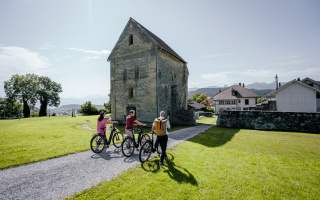
Many Roads Lead to Rüeggisberg
Countless hiking trails crisscross the Gantrisch region and lead through the idyllic landscape. An impressive high-altitude hike over the Längenberg with a breathtaking view of the Eiger, Mönch and Jungfrau offers a heart-pounding adventure. While on the trail of the Cluniac monks, some day-trippers have already visited and experienced the ruins of the Rüeggisberg Monastery, claiming it as a place of special energy.
Anyone who has a thirst for more history, background information and archaeological artifacts can also stop in at the museum located right next to the ruins.
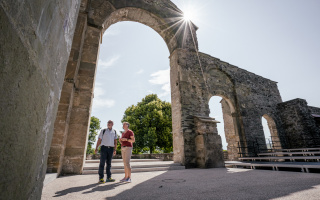
Events and Cultural Highlights
A select program of events breathe life back into the splendid medieval architecture all year round. In July and August, a mix of renowned, local and upcoming artists offers a premium-quality cultural program. As part of the “Klostersommer” (Monastery Summer) event, performers from the genres of music, theater and comedy share the stage. The “Irish & Celtic Night” forms an established part of the entertainment lineup.
The annual “KlosterSkulpturenAusstellung” (MonasterySculptureExhibition) is particularly popular. The always expanding open-air exhibition fascinates art lovers with installations and sculptures made from wood, metal and sandstone displayed in public spaces. The pieces of artwork for this “art-in-public” project are always assembled on Pentecost and taken down in the fall. During the same time period, the Rüeggisberg Monastery also hosts a church service once a month.
In the winter, the classic and well-organized Advent Market transforms the monastery’s interior. As you stroll from stand to stand and let yourself be enchanted by the festive lighting, smells and decorations, it won't take long for you to find yourself in a very jolly Christmas mood.
You might also like
-
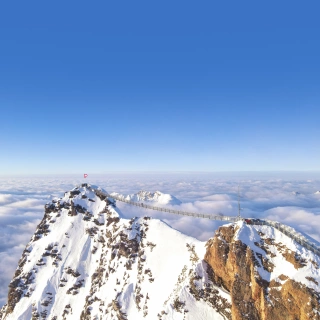 Activitäten > Ausflüge, Aktivitäten > Wandern, Aktivitäten > WinteraktivitätenGlacier 3000More
Activitäten > Ausflüge, Aktivitäten > Wandern, Aktivitäten > WinteraktivitätenGlacier 3000More -
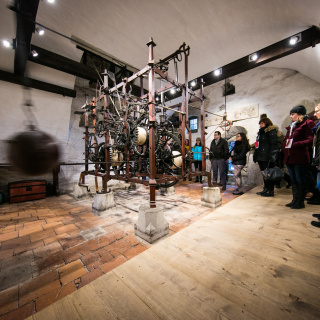 City Tours, Meetings & Kongresse > Darum Bern, Meetings & Kongresse > Darum BernTour of the Zytglogge (Clock Tower)More
City Tours, Meetings & Kongresse > Darum Bern, Meetings & Kongresse > Darum BernTour of the Zytglogge (Clock Tower)More -
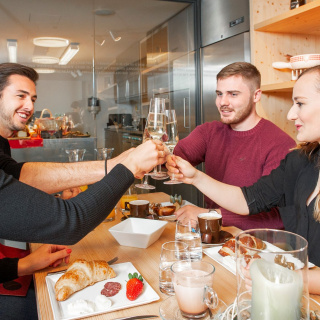 Essen & Ausgehen > Brunch, Meetings & Kongresse > Darum Bern, Meetings & Kongresse > Darum BernBrunch at «ChäsChäuer»More
Essen & Ausgehen > Brunch, Meetings & Kongresse > Darum Bern, Meetings & Kongresse > Darum BernBrunch at «ChäsChäuer»More -
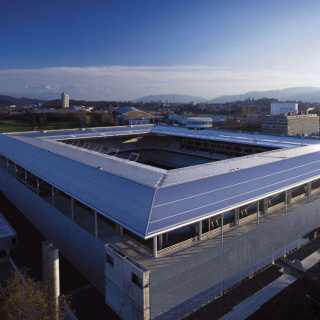 Aktivitäten > Adventure & Sport, Meetings & Kongresse > Darum Bern, Meetings & Kongresse > Darum BernBSC Young BoysMore
Aktivitäten > Adventure & Sport, Meetings & Kongresse > Darum Bern, Meetings & Kongresse > Darum BernBSC Young BoysMore

